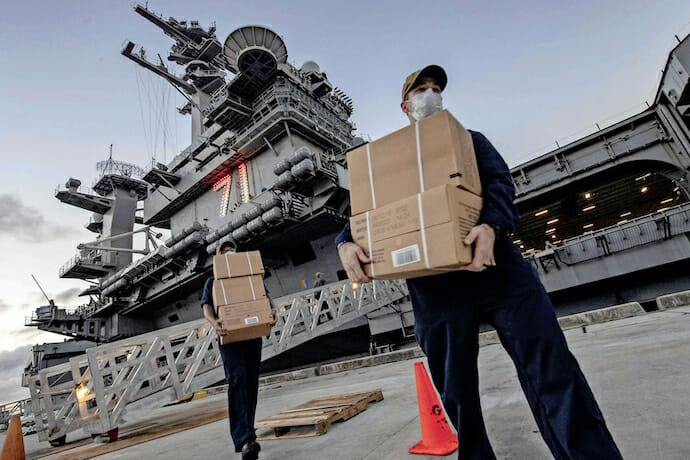
COVID-19, the South China Sea, and U.S. Policy
The outbreak of COVID-19 on board the U.S. aircraft carrier USS Theodore Roosevelt presents a challenge for the single element of U.S. foreign policy that has remained consistent throughout history.
In this age that requires equal status for all six branches of the U.S. military regardless of practicality, one tends to neglect the fact that the U.S. Navy for most of its history was the cutting edge of U.S. foreign policy and the U.S. was regarded as essentially a maritime power.
The Naval Act of 1794 authorized six frigates, including the USS Constitution, precursors of what, in the twentieth century would be classified as battlecruisers. This expressed the U.S. aversion to European conflicts. The U.S. was, however, pledged to protect American Naval and mercantile shipping from attack. The six ships constructed were intended to either confront hostile frigates, the 18th century equivalent of cruisers, or to serve as bases for punitive raids on any shores conceived to have threatened American shipping and interests.
A relatively strong navy enabled Congress to mandate an army that was minuscule for a nation of such enormity. Free navigation, the insistence of the legal right of American ships to sail through all international waters was and is the great unchanged element of American foreign policy, the last survivor of the triad that also counted isolationism and the Monroe Doctrine.
Almost all of the foreign military encounters prior to and indeed including World War Two involved threats, perceived and real, to America’s commerce and the Navy established to protect it. From the undeclared “Quasi War” of 1798 to 1800 with France, the United States has resorted to military action against foreign opponents thirteen times. No American president has hesitated in reaffirming that any attack on American vessels is to be considered a casus belli, a notorious modern example being the questionable 1964 Gulf of Tonkin incident that was used to justify American intervention in the whole of Southeast Asia.
Since then the U.S. has felt again required to reaffirm the rights of passage by the United States Navy through the Gulf of Sidra, the Straits of Hormuz, the Straights of Taiwan and the South China Sea.

For this, aircraft carriers are essential. Airfields and fortifications are constructed to meet present and anticipated needs. Any reader of Nassim Nicholas Taleb, however, will point out that the great events of history are by definition, those that are unanticipated. Unlike static airfields and especially unlike static fortifications, carriers go where needed. Planning and structures built for an anticipated confrontation with the Soviet Union have happily been made obsolete and new perceived international enemies in different regions have unhappily arisen. An aircraft carrier can be moved to a trouble spot in one day and removed the day that the trouble ceases.
The continuing moves by China to occupy the coastal islands and islets of Vietnam, Malaysia, Brunei, and the Philippines, the area dubbed as “the nine-dash line,” is the kind of direct challenge that the U.S. Navy, and particularly its aircraft carriers, are designed to face. It can be suggested that successful occupation of more than a few of these minuscule rocks and atolls would not only turn most of the South China Sea over to Chinese economic exploitation, it might if the Chinese were to choose, render null the independence of those nations who now would be in minutes from bombardment.
In the long run, either an acceptable international convention will be achieved or the U.S. will feel constrained first, to support a boundary settlement among those South China Sea nations that perhaps imagine themselves threatened, and secondly sponsor and maintain those nations’ establishments of permanent bases on all the islets in question, thus forgoing attempts, real or imagined, at foreign occupation.
Until that time, however, there are the carriers. Instead of being on station, the USS Theodore Roosevelt, with its huge complement of sailors, marines, and aviators is docked at Guam with an ever-increasing number of its complement infected and dying from COVID-19. While accommodations for the crew are much more comfortable and spacious than for those who served in the Second World War and would seem miraculous to the tars who served on the Constitution, working space by necessity is still more confined than in any of the private industries that have already shut down for fear of forcing personnel into too close proximity.
At the moment, therefore, there is a novel problem for military planners: will China take advantage of the temporary indisposition of the U.S. Navy? Ironically here, the only silver lining might be the rather morbid comfort that China too, is a victim of the virus and its Navy also might be under the same constraints. Yet reports of a Chinese Navy flotilla in the Pacific suggest that the Chinese navy and military as a whole does not have a COVID-19 problem and is in better condition for a conflict that its American counterpart. There has also been some indication that the Chinese are, without much fanfare, once again increasing a presence in that region.
The other great and perhaps more significant deterrence to overt hostilities is the tangle of economic and diplomatic ties between the two nations. An armed conflict over the South China Sea would involve such disruptions as to threaten the very economic existences of both nations. This should be sufficient deterrence. Unhappily, relations between the United States and China are less happy than they have been in the past and history has demonstrated that rationality in international affairs is too often in short supply. In any case, a strategy based on a potential adversary’s anticipated goodwill and logical thinking is hardly the firmest foundation for security.
How severe the problem will become, how many ships and how many men become infected may not be known for many years, since such figures would be a revelation of weaknesses in American defense. Likewise, the truth of the reports of a Chinese fleet currently healthier than its American counterpart might, happily perhaps, need wait for the historians.
One certainty: humans are biological entities and as such will always be susceptible to other biological entities. The announcement by the French Navy that over half of the complement of the aircraft carrier Charles de Gaulle is infected indicates that the problem cannot be considered endemic to any particular seagoing force. COVID-19 may not prove to be the worst pandemic; it certainly will not be the last; Navy policy, practice, architecture, and technology must accept this as a permanent factor.
